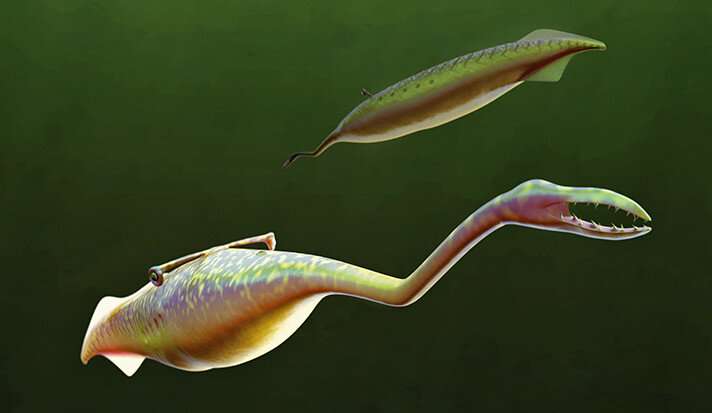May 7, 2020 report
Chemical analysis of Tully monster suggests it was a vertebrate

A team of researchers affiliated with several institutions in the U.S. and one in Germany has found evidence that suggests the Tully monster was a vertebrate. In their paper published in the journal Geobiology, the group describes their Raman micro-spectroscopy study of the ancient creatures and what they learned about them.
The Tully monster (Tullimonstrum gregarium) was first discovered in 1958 at a site in modern Illinois. Dating of the fossilized remains showed that it lived approximately 300 million years ago. But the researchers were not able to identify a vertebra, thus its status was not clear. Since that time, more Tully monster fossils have been uncovered (all from the same site at Mazon Creek) and more has been learned about it—it had a long, streamlined body and eyes like a hammerhead. It was also relatively small, approximately the size of a bowling pin. But despite numerous studies, researchers could not reach a consensus regarding its backbone. In this new effort, the researchers approached the problem from a new angle. Instead of trying to figure out if the Tully monster was a true vertebrate by doing anatomical studies, the researchers instead chose to approach it from a chemical perspective. They noted that invertebrates have chitin in their harder tissues that help them keep their form—chitin is made from long strings of sugar molecules. In contrast, vertebrates have certain kinds of proteins and keratin that make up the collagen that is found in back-boned animals.
The work involved using Raman micro-spectroscopy to study the chemical structure in the parts of the fossils that were most likely to have been the site of a backbone, if the creature had one. Such an approach involves firing a laser in a non-destructive way at a specimen and then measuring the vibrations that are related to chemical bonds in the material under study. The work showed evidence of the types of proteins and keratins representative of vertebrates. They suggest their findings provide strong evidence that the Tully monster was a vertebrate, though they acknowledge that more work is required to make a final confirmation.
More information: Victoria E. McCoy et al. Chemical signatures of soft tissues distinguish between vertebrates and invertebrates from the Carboniferous Mazon Creek Lagerstätte of Illinois, Geobiology (2020). DOI: 10.1111/gbi.12397
© 2020 Science X Network





















